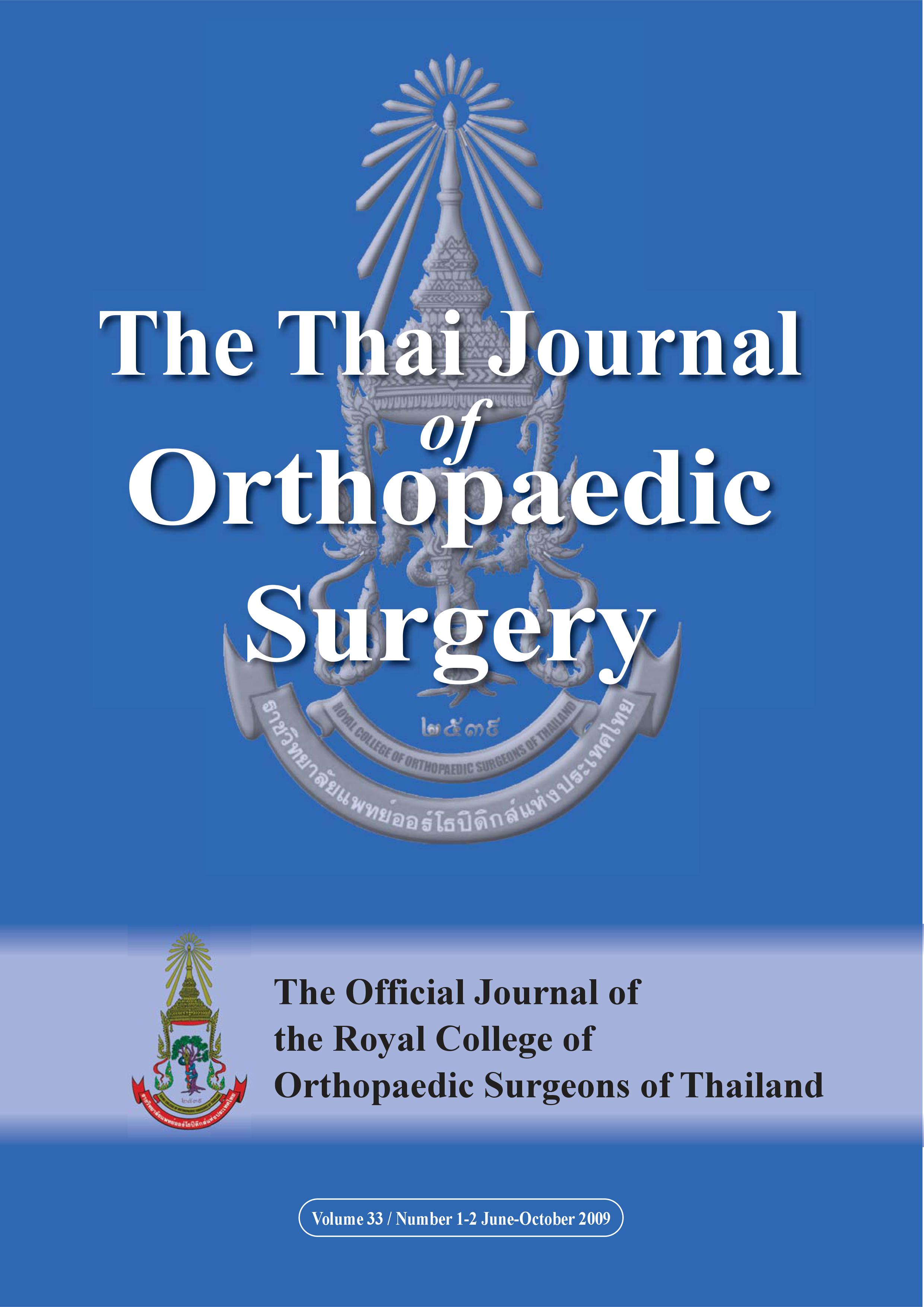Intermediate Screws in Short Segment Pedicular Fixation for Thoracolumbar and Lumbar Burst Fractures
Main Article Content
Abstract
Purpose: To evaluate the clinical relevance of short segment pedicular fixation with intermediate screws.
Methods: Retro- and prospective studies were done of 29 patients with thoracolumbar or lumbar burst fractures who were treated with posterior short segment pedicular fixation. Anterior vertebral body height compression percentage (AVBCP) and local kyphosis were measured and analyzed pre-operatively, post-operatively, and at last follow-up period. All patients were followed up for a minimum of 6 months.
Results: The mean immediate post-operative corrections of AVBCP and kyphosis were 24±15% and 14±8° respectively. The mean losses of correction at the last follow-up period were 0% and 2.2° for AVBCP and kyphosis respectively. At last follow-up, there was significant loss of correction of kyphosis (p<.001), whereas lost of correction of AVBCP was not significant (p=0.135). The final kyphotic angle at the latest follow-up period compared to the preoperative value was significantly improved (p<.001). There was no evidence of instrument failure or neurological deterioration in this study.
Conclusions: Short segment pedicular fixation with intermediate screws is safe and effective in the surgical treatment of thoracolumbar and lumbar burst fractures. It provides significant correction of vertebral body height and local kyphosis, and maintains the correction.
Article Details
References
2. Dick W, Kluger P, Magerl F, Woersdorfer O, Zach G. A new device for internal fixation of thoracolumbar and lumbar spine fractures: the 'fixateur interne'. Paraplegia. 1985 Aug;23(4):225-32.
3. Benson DR, Burkus JK, Montesano PX, et al. Unstable thoracolumbar and lumbar burst fracture treated with the AO fixateur interne. J Spine Disord 1992;5:335-43.
4. McLain RF, Sparling E, Benson DR. Early failure of short-segment pedicle instrumentation for thoracolumbar fractures. A preliminary report. J Bone Joint Surg Am. 1993 Feb;75(2):162-7.
5. Dick JC, Jones MP, Zdeblick TA, Kunz DN, Horton WC. A biomechanical comparison evaluating the use of intermediate screws and cross-linkage in lumbar pedicle fixation. J Spinal Disord. 1994 Oct;7(5):402-7.
6. Lynn G, Mukherjee DP, Kruse RN, Sadasivan KK, Albright JA. Mechanical stability of thoracolumbar pedicle screw fixation. The effect of crosslinks. Spine. 1997 Jul 15;22(14):1568-72;discussion 73.
7. Dick JC, Zdeblick TA, Bartel BD, Kunz DN. Mechanical evaluation of cross-link designs in rigid pedicle screw systems. Spine. 1997 Feb 15;22(4):370-5.
8. Leduc S, Mac-Thiong JM, Maurais G, Jodoin A. Posterior pedicle screw fixation with supplemental laminar hook fixation for the treatment of thoracolumbar burst fractures. Can J Surg. 2008 Feb;51(1):35-40.
9. de Peretti F, Hovorka I, Cambas PM, Nasr JM, Argenson C. Short device fixation and early mobilization for burst fractures of the thoracolumbar junction. Eur Spine J. 1996;5(2):112-20.
10. Acosta FL, Jr., Aryan HE, Taylor WR, Ames CP. Kyphoplasty-augmented short-segment pedicle screw fixation of traumatic lumbar burst fractures: initial clinical experience and literature review. Neurosurg Focus. 2005 Mar 15;18(3):e9.
11. Korovessis P, Repantis T, Petsinis G, Iliopoulos P, Hadjipavlou A. Direct reduction of thoracolumbar burst fractures by means of balloon kyphoplasty with calcium phosphate and stabilization with pedicle-screw instrumentation and fusion. Spine. 2008 Feb 15;33(4):E100-8.
12. Korovessis P, Hadjipavlou A, Repantis T. Minimal invasive short posterior instrumentation plus balloon kyphoplasty with calcium phosphate for burst and severe compression lumbar fractures. Spine. 2008 Mar 15;33(6):658-67.
13. Oner FC, Verlaan JJ, Verbout AJ, Dhert WJ. Cement augmentation techniques in traumatic thoracolumbar spine fractures. Spine. 2006 May 15; 31(11 Suppl):S89-95;discussion S104.
14. Anekstein Y, Brosh T, Mirovsky Y. Intermediate screws in short segment pedicular fixation for thoracic and lumbar fractures: a biomechanical study. J Spinal Disord Tech. 2007 Feb;20(1):72-7.
15. Mahar A, Kim C, Wedemeyer M, Mitsunaga L, Odell T, Johnson B, et al. Short-segment fixation of lumbar burst fractures using pedicle fixation at the level of the fracture. Spine. 2007 Jun 15;32(14):1503-7.
16. McAfee PC, Yuan HA, Fredrickson BE, Lubicky JP. The value of computed tomography in thoracolumbar fractures. An analysis of one hundred consecutive cases and a new classification. J Bone Joint Surg Am. 1983 Apr;65(4):461-73.
17. Keynan O, Fisher CG, Vaccaro A, Fehlings MG, Oner FC, Dietz J, et al. Radiographic measurement parameters in thoracolumbar fractures: a systematic review and consensus statement of the spine trauma study group. Spine. 2006 Mar 1;31(5):E156-65.
18. Alanay A, Acaroglu E, Yazici M, Oznur A, Surat A. Short-segment pedicle instrumentation of thoracolumbar burst fractures: does transpedicular intracorporeal grafting prevent early failure? Spine. 2001 Jan 15;26(2):213-7.
19. Denis F. Spinal instability as defined by the three-column spine concept in acute spina l trauma.Clin. Orthop. 1984;189:65-76.
20. Frankel HL, Hancock DO, Hyslop G, et al: The value of postural reduction in the initial management of closed injuries of the spine with paraplegia and tetraplegia. Paraplegia 1969:7:179-92.
21. Acikbas SC, Arslan FY, Tuncer MR. The effect of transpedicular screw misplacement on late spinal stability. Acta Neurochir (Wien). 2003 Nov; 145(11):949-54;discussion 54-5.

